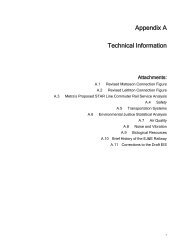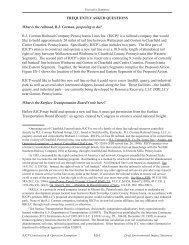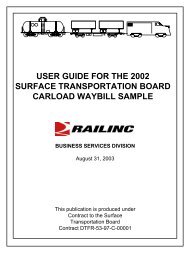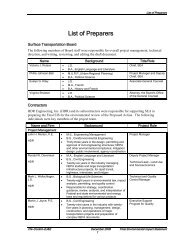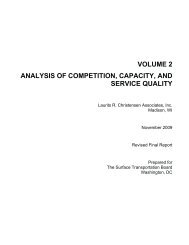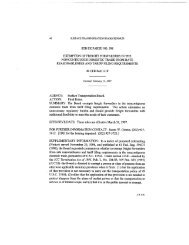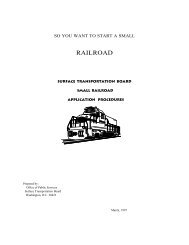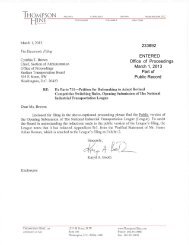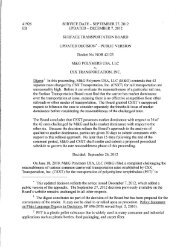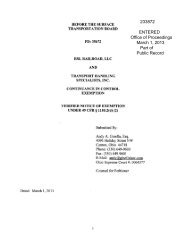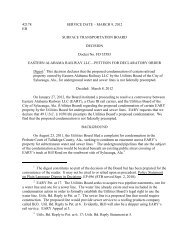Norfolk Southern/Conrail Rail ConnectionâBucyrus, Ohio - Surface ...
Norfolk Southern/Conrail Rail ConnectionâBucyrus, Ohio - Surface ...
Norfolk Southern/Conrail Rail ConnectionâBucyrus, Ohio - Surface ...
Create successful ePaper yourself
Turn your PDF publications into a flip-book with our unique Google optimized e-Paper software.
STB Finance Docket No. 33388<br />
application. Creating separate dockets for these connections, according to SDI, will not be an<br />
efficient use of the Board’s resources nor permit an adequate review of the issues involved in the<br />
Midwest region. SDI contends that the proposed transfer of NSR’s Fort Wayne line to CRC,<br />
followed by CRC’s transfer of the line, under a long-term operating agreement, to CSXT, see<br />
Decision No. 4, slip op. at 6-7, is intended to disguise the asserted fact that the acquisition of <strong>Conrail</strong><br />
will create duplicate Chicago-bound lines only about 25 miles apart, running through Waterloo and<br />
Fort Wayne, IN. SDI maintains that our consideration of issues as complex as NSR’s proposed<br />
connections and the possible divestiture of duplicate lines should not precede our review of the<br />
primary application. 12<br />
The Allied <strong>Rail</strong> Unions. ARU opposes the CSX-1 and NS-1 waiver petitions as inconsistent<br />
with our review of the primary application. ARU argues that, by requesting the waivers, CSXT and<br />
NSR seek leverage for our ultimate approval of the application, while allegedly evading public<br />
scrutiny and comment on the transaction as a whole. ARU maintains that the construction projects<br />
are directly related to, and are dependent on, our approval of the primary transaction, and that the<br />
construction projects should be authorized only if the transaction itself is authorized. ARU argues<br />
that our merger regulations already confer a significant advantage on the applicants because they<br />
may immediately file for related abandonments and line transfers, even though they do not currently<br />
own the affected lines. ARU avers that, as a consequence, CSXT and NSR have no basis to seek<br />
additional advantage through their waiver requests. ARU contends that applicants offered no<br />
evidence to support their “competitive disadvantage” or “delay of public benefits” arguments.<br />
According to the unions, the applicants’ arguments on competitive disadvantage are inherently<br />
inconsistent because both carriers assert that they will be disadvantaged unless their respective<br />
petitions are granted. Accordingly, ARU believes that a reasonable competitive balance can be<br />
maintained by denying both waiver petitions.<br />
American Trucking Associations, Inc. ATA asks us to reserve judgment on the seven<br />
construction projects until the primary application is filed and reviewed by the parties. ATA<br />
contends that our approval of the waivers, despite any disclaimer to the contrary, could be<br />
interpreted by the public as tacit support for the primary application and inadvertently stifle full<br />
debate on the relevant issues. According to ATA, early consideration of the construction projects<br />
will unreasonably burden the parties and the Board’s staff by requiring incremental participation in<br />
the transaction approval process. ATA also maintains that the competitive impact of the seven<br />
construction projects could not be adequately determined in the absence of consideration of the<br />
primary application.<br />
12<br />
SDI also asserts that NS has not sought waiver of our requirement that waiver petitions be filed at least 45 days<br />
prior to the filing of the primary application. See 49 CFR 1180.4(f)(2). SDI therefore asks us to clarify that NS may<br />
not file its application before June 16, 1997, regardless of whether NS-1 is granted. We note that, in accordance<br />
with the procedural schedule adopted in Decision No. 6 (served and published on May 30, 1997) applicants may not<br />
file their primary application until 30 days after the filing of applicants’ Preliminary Environmental Report, which<br />
was filed on May 16, 1997. The primary application, therefore, may be filed only on or after June 16, 1997. SDI’s<br />
request in this regard is moot.<br />
-6-




